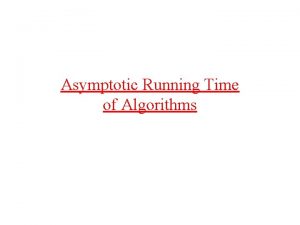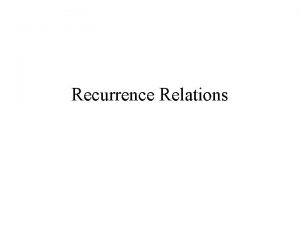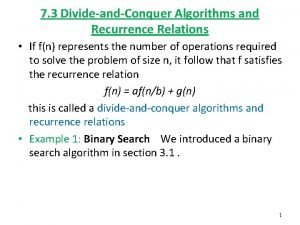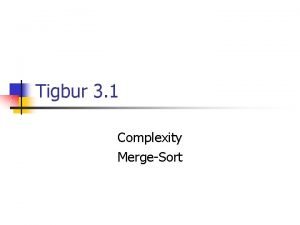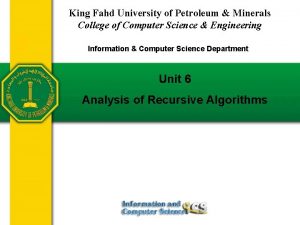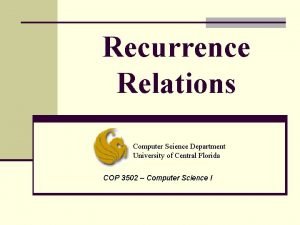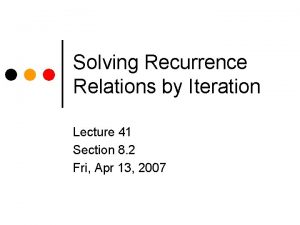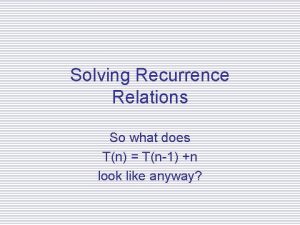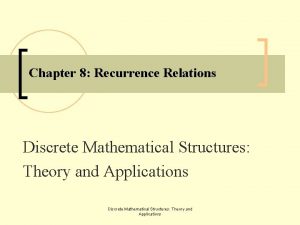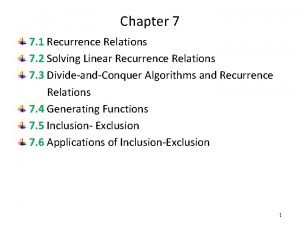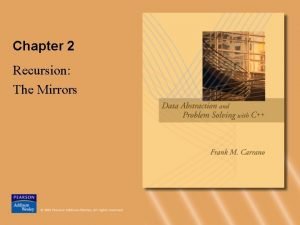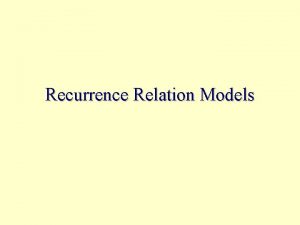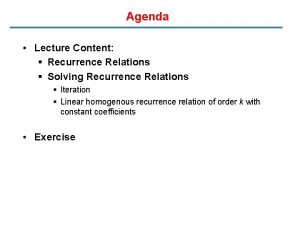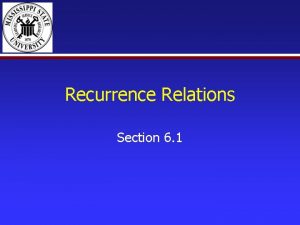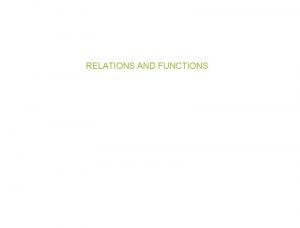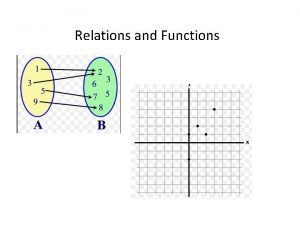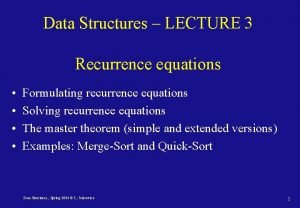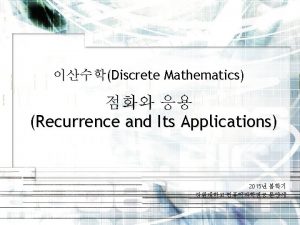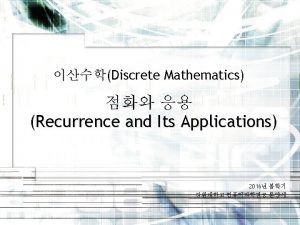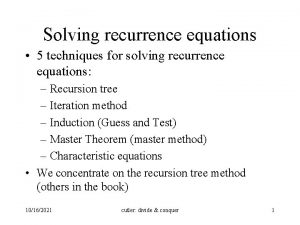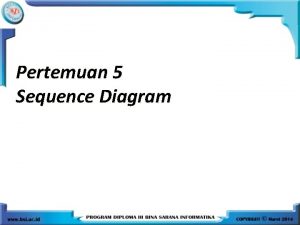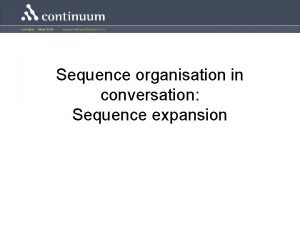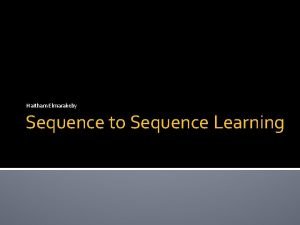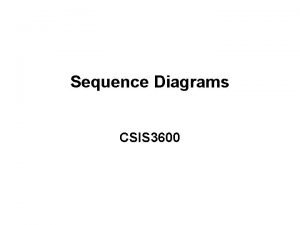Recurrence Relations A recurrence relation for the sequence




















- Slides: 20


Recurrence Relations A recurrence relation for the sequence {an} is an equation that expresses an is terms of one or more of the previous terms of the sequence, namely, a 0, a 1, …, an-1, for all integers n with n n 0, where n 0 is a nonnegative integer. A sequence is called a solution of a recurrence relation if it terms satisfy the recurrence relation.

Recurrence Relations In other words, a recurrence relation is like a recursively defined sequence, but without specifying any initial values (initial conditions). Therefore, the same recurrence relation can have (and usually has) multiple solutions. If both the initial conditions and the recurrence relation are specified, then the sequence is uniquely determined

Example: Consider the recurrence relation an = 2 an-1 – an-2 for n = 2, 3, 4, … Is the sequence {an} with an=3 n a solution of this recurrence relation? For n 2 we see that 2 an-1 – an-2 = 2(3(n – 1)) – 3(n – 2) = 3 n = an. Therefore, {an} with an=3 n is a solution of the recurrence relation. Is the sequence {an} with an=5 a solution of the same recurrence relation? For n 2 we see that 2 an-1 – an-2 = 2 5 - 5 = an. Therefore, {an} with an=5 is also a solution of the recurrence relation

Applications : Financial Recurrence Relations Example: Someone deposits $10, 000 in a savings account at a bank yielding 5% per year with interest compounded annually. How much money will be in the account after 30 years? We can derive the following recurrence relation: Pn = Pn-1 + 0. 05 Pn-1 = 1. 05 Pn-1. The initial condition is P 0 = 10, 000. Then we have: P 1 = 1. 05 P 0 P 2 = 1. 05 P 1 = (1. 05)2 P 0 P 3 = 1. 05 P 2 = (1. 05)3 P 0 … Pn = 1. 05 Pn-1 = (1. 05)n. P 0

Application: Partition Function A partition of a set is a way of grouping all the elements disjointly. EG: All the partitions of {1, 2, 3} are: 1. { {1, 2, 3} } 2. { {1, 2}, {3} } 3. { {1, 3}, {2} } 4. { {2, 3}, {1} } 5. { {1}, {2}, {3} } The partition function pn counts the number of partitions of {1, 2, …, n}. Thus p 3 = 5.

Let’s find a recursion relation for the partition function. There are n possible scenarios for the number of members on n’s team: 0: n is all by itself (e. g. {{1, 2}, {3}}) 1: n has 1 friend (e. g. {{1}, {2, 3}}) 2: n has 2 friends (e. g. {{1, 2, 3}}) … n-1: n has n-1 friends on its team. By the sum rule, we need to count the number of partitions of each kind, and then add together.

Consider the k’ th case: k: n has k friends There are C (n-1, k) ways of choosing fellow members of n’s team. Furthermore, there are pn-k-1 ways of partitioning the rest of the n elements. Using the product and sum rules we get:

Application : Binary Search Recurrence relations are also of fundamental importance in Analysis of Algorithms. If an algorithm is designed so that it will break a problem into smaller sub problems, its running time is described by a recurrence relation. A simple example is the time an algorithm takes to search an element in an ordered vector with elements, in the worst case. A naive algorithm will search from left to right, one element at a time. The worst possible scenario is when the required element is the last, so the number of comparisons is. A better algorithm is called BINARY SEARCH. It will first check is the element is at the middle of the vector. If not, then it will check if the middle element is greater or lesser than the seeked element. At this point, half of the vector can be discarded, and the algorithm can be ran again on the other half. The number of comparisons will be given by C 1=1 Cn=1+Cn/2 which will be close to log 2(n)

Solving Recurrence Relations In general, we would prefer to have an explicit formula to compute the value of an rather than conducting n iterations. For one class of recurrence relations, we can obtain such formulas in a systematic way. Those are the recurrence relations that express the terms of a sequence as linear combinations of previous terms.

Solving Recurrence Relations Definition: A linear homogeneous recurrence relation of degree k with constant coefficients is a recurrence relation of the form: an = c 1 an-1 + c 2 an-2 + … + ckan-k, Where c 1, c 2, …, ck are real numbers, and ck 0. A sequence satisfying such a recurrence relation is uniquely determined by the recurrence relation and the k initial conditions a 0 = C 0, a 1 = C 1, a 2 = C 2, …, ak-1 = Ck-1.

Solving Recurrence Relations Basically, when solving such recurrence relations, we try to find solutions of the form an = rn, where r is a constant. an = rn is a solution of the recurrence relation an = c 1 an-1 + c 2 an-2 + … + ckan-k if and only if rn = c 1 rn-1 + c 2 rn-2 + … + ckrn-k. Divide this equation by rn-k and subtract the right-hand side from the left: rk - c 1 rk-1 - c 2 rk-2 - … - ck-1 r - ck = 0 This is called the characteristic equation of the recurrence relation

Solving Recurrence Relations The solutions of this equation are called the characteristic roots of the recurrence relation. Let us consider linear homogeneous recurrence relations of degree two. Theorem: Let c 1 and c 2 be real numbers. Suppose that r 2 – c 1 r – c 2 = 0 has two distinct roots r 1 and r 2. Then the sequence {an} is a solution of the recurrence relation an = c 1 an-1 + c 2 an-2 if and only if an = 1 r 1 n + 2 r 2 n for n = 0, 1, 2, …, where 1 and 2 are constants.

Solving Recurrence Relations Example: What is the solution of the recurrence relation an = an-1 + 2 an-2 with a 0 = 2 and a 1 = 7 ? Solution: The characteristic equation of the recurrence relation is r 2 – r – 2 = 0. Its roots are r = 2 and r = -1. Hence, the sequence {an} is a solution to the recurrence relation if and only if: an = 12 n+ 2(-1) n for some constants 1 and 2.

Solving Recurrence Relations Given the equation an = = 7, it follows that a 0 = 2 = 1+ a 1 = 7 = 12 + 12 n+ 2(-1) n and the initial conditions a 0 = 2 and a 1 2 2 (-1) Solving these two equations gives us 1 = 3 and 2 = -1. Therefore, the solution to the recurrence relation and initial conditions is the sequence {an} with an = 3 2 n – (-1)n.

Solving Recurrence Relations Example: Give an explicit formula for the Fibonacci numbers. Solution: The Fibonacci numbers satisfy the recurrence relation fn = fn-1 + fn-2 with initial conditions f 0 = 0 and f 1 = 1. The characteristic equation is r 2 – r – 1 = 0. Its roots are r 1 1 5 2 , r 2 1 5 2

Solving Recurrence Relations Therefore, the Fibonacci numbers are given by 1 fn 5 1 n 1 2 2 5 n 2 for some constants α 1 and α 2. We can determine values for these constants so that the sequence meets the conditions f 0 = 0 and f 1 = 1: f 0 f 1 1 2 1 1 0 5 2 1 2 5 2 1

Solving Recurrence Relations The unique solution to this system of two equations and two variables is 1 1 , 5 2 1 5 So finally we obtained an explicit formula for the Fibonacci numbers: fn 1 1 5 2 5 n

Solving Recurrence Relations But what happens if the characteristic equation has only one root? How can we then match our equation with the initial conditions a 0 and a 1 ? Theorem: Let c 1 and c 2 be real numbers with c 2 0. Suppose that r 2 – c 1 r – c 2 = 0 has only one root r 0. A sequence {an} is a solution of the recurrence relation an = c 1 an-1 + c 2 an-2 if and only if an = 1 r 0 n + 2 nr 0 n, for n = 0, 1, 2, …, where 1 and 2 are constants.

Solving Recurrence Relations Example: What is the solution of the recurrence relation an = 6 an-1 – 9 an-2 with a 0 = 1 and a 1 = 6? Solution: The only root of r 2 – 6 r + 9 = 0 is r 0 = 3. Hence, the solution to the recurrence relation is an = 13 n + 2 n 3 n for some constants 1 and 2. To match the initial condition, we need a 0 = 1 = a 1 = 6 = 1 1 3+ 23 Solving these equations yields 1 = 1 and 2= 1. Consequently, the overall solution is given by an = 3 n + n 3 n.
 Recurrence relation
Recurrence relation Solving linear homogeneous recurrence relations
Solving linear homogeneous recurrence relations Homogeneous recurrence relation
Homogeneous recurrence relation Asymptotic cheat sheet
Asymptotic cheat sheet The expression is a
The expression is a Recurrence relation
Recurrence relation Algorithm recurrence relation
Algorithm recurrence relation Bubble sort recurrence relation
Bubble sort recurrence relation Recurrence relation of recursive selection sort
Recurrence relation of recursive selection sort Recurrence computer science
Recurrence computer science Solving recurrence relations by iteration
Solving recurrence relations by iteration Recurrence relation for linear search
Recurrence relation for linear search Recurrence relation in discrete mathematics
Recurrence relation in discrete mathematics Recurrence relation
Recurrence relation Rabbits and recurrence relations
Rabbits and recurrence relations Employee relations in public relations
Employee relations in public relations Get sequence get another sequence pseudocode
Get sequence get another sequence pseudocode The difference between will and going to
The difference between will and going to Convolutional sequence to sequence learning.
Convolutional sequence to sequence learning. Amino acid nucleotide
Amino acid nucleotide Matematisk modellering eksempel
Matematisk modellering eksempel



